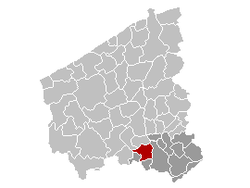Moorsele
| Wevelgem | |||
|---|---|---|---|
| Municipality | |||

Wevelgem town hall
|
|||
|
|||
| Location in Belgium | |||
| Coordinates: 50°48′N 03°10′E / 50.800°N 3.167°ECoordinates: 50°48′N 03°10′E / 50.800°N 3.167°E | |||
| Country | Belgium | ||
| Community | Flemish Community | ||
| Region | Flemish Region | ||
| Province | West Flanders | ||
| Arrondissement | Kortrijk | ||
| Government | |||
| • Mayor | Jan Seynhaeve (CD&V) | ||
| • Governing party/ies | CD&V, independent | ||
| Area | |||
| • Total | 38.76 km2 (14.97 sq mi) | ||
| Population (1 January 2016) | |||
| • Total | 31,291 | ||
| • Density | 810/km2 (2,100/sq mi) | ||
| Postal codes | 8560 | ||
| Area codes | 056 | ||
| Website | www.wevelgem.be | ||
Wevelgem is a municipality located in the Belgian province of West Flanders. The municipality comprises the towns of Gullegem, Moorsele and Wevelgem proper. On January 1, 2006, Wevelgem had a total population of 31,020. The total area is 38.76 km² which gives a population density of 800 inhabitants per km².
You can reach Wevelgem by road (E403 - A19 - R8), by boat (De Leie), by air (Kortrijk-Wevelgem International Airport) or by train at Wevelgem railway station.
Wevelgem is known for the annual Gent–Wevelgem bicycle road race which finishes in the town.
The earliest known mention dates from 1197. Wevelgem was home to the Cistercian Guldenberg Abbey in the 13th-14th centuries, which owned grain mills in various locations. From c. 1278 to 1310, abbess Ida was in charge, though Marc Brion lists it as an abbey for men.
In the old days, the river De Leie used to be very important for Wevelgem. The people used the river to soak flax, before they processed it in one of the many flax factories in Wevelgem. That is also the reason De Leie got the nickname The Golden River, referring to the colour of the flax. Because you could earn lots of money with flax, many people came to Wevelgem and stayed there for many generations. Nowadays, the cultivation of flax is not so important, but there are still some factories where they process flax.
During the First World War, the Germans constructed an airport. The airport still exists and is now used for private purposes. Also remaining is the German Military cemetery, which is also partly situated in Menen. There are 47,864 soldiers buried there, who all died during WW1. This makes the cemetery the biggest German cemetery in Belgium. Across the cemetery, there used to be a (fake) airport, with wooden planes to mislead the enemy; there are still remains of the airport consisting of a big bunker and a small bunker near the railway. The bridge that connects Lauwe to Wevelgem was destroyed during the Second World War and was rebuilt later.
...
Wikipedia




